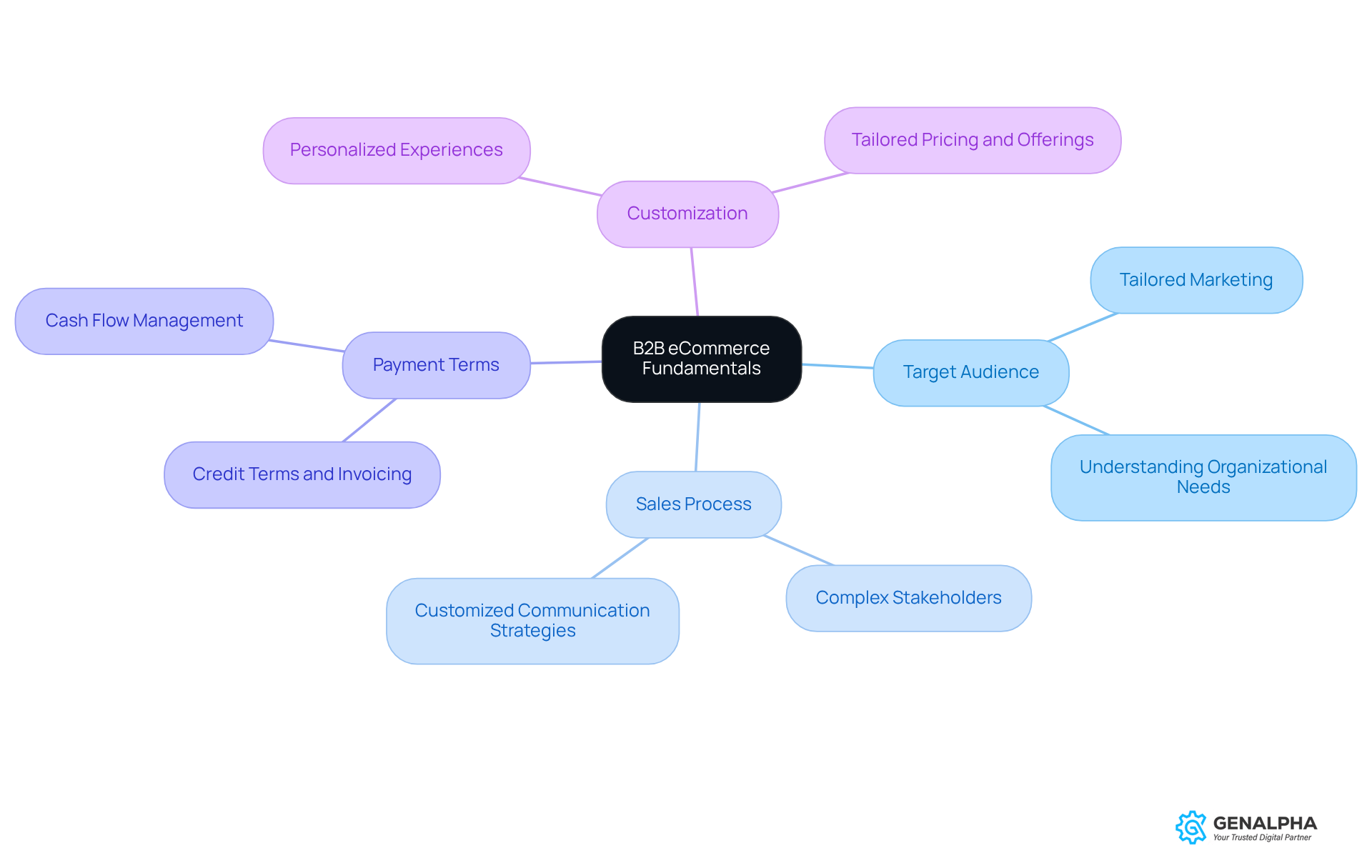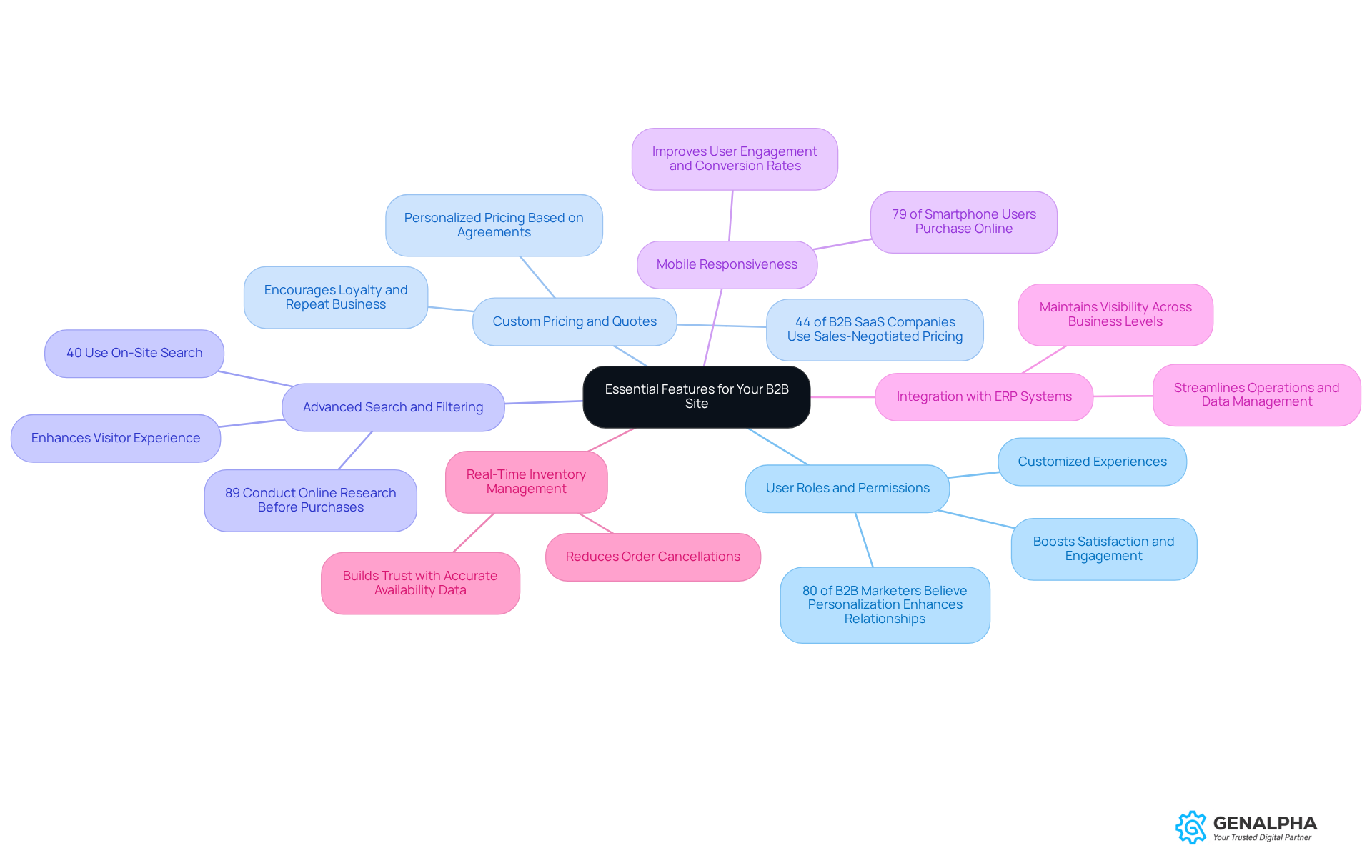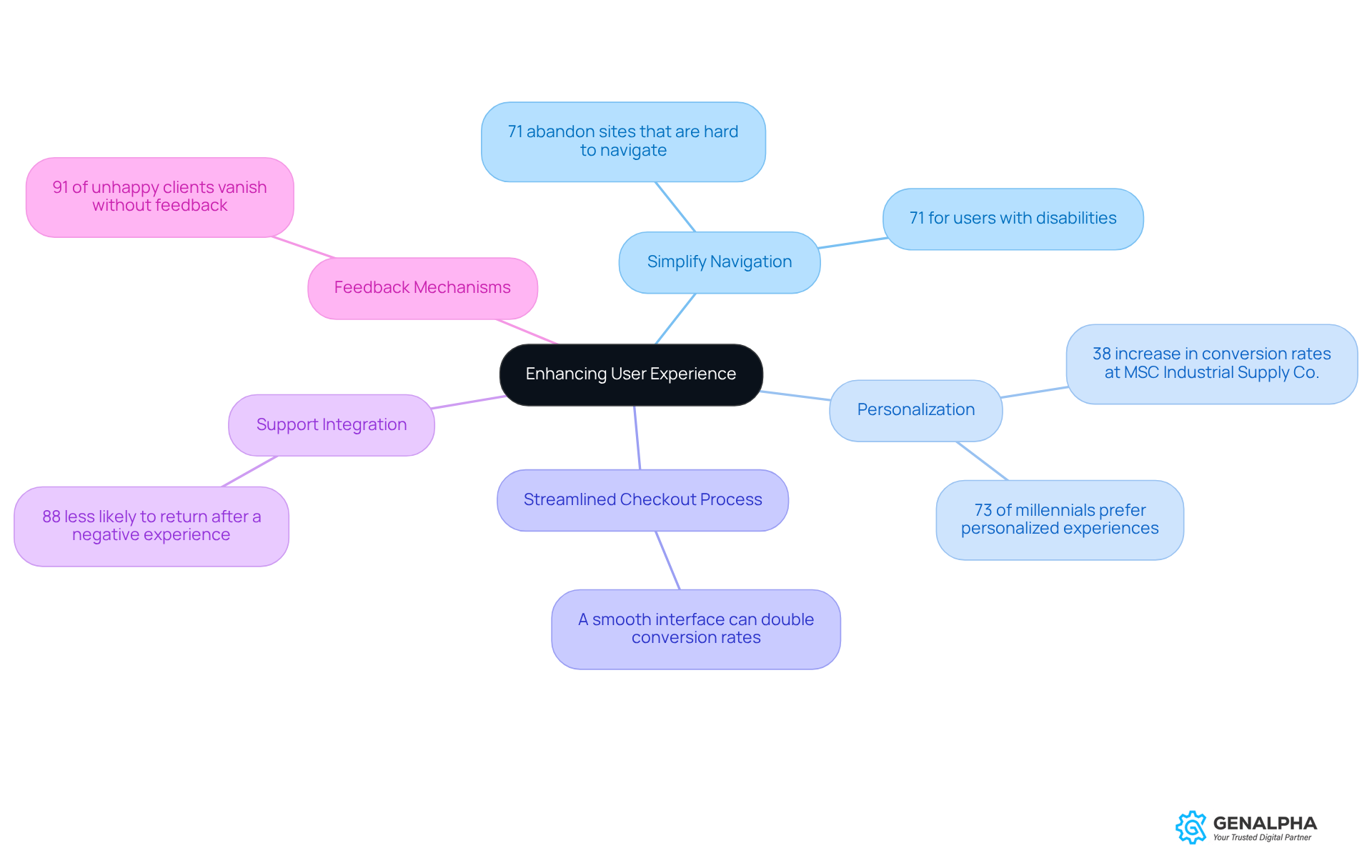Overview
Let’s dive into the four essential steps that can really help optimize your B2B eCommerce site for success. First up, it’s all about grasping the fundamentals of B2B. Have you ever thought about how different B2B transactions can be? Understanding these basics sets the stage for everything else.
Next, we need to identify those key features that your site should have. Think about:
- Personalized pricing
- Robust user roles
These aren’t just nice-to-haves; they’re crucial for addressing the unique complexities of B2B transactions. Additionally, enhancing user experience is vital. How can we make it easier for customers to navigate your site and find what they need?
Finally, let’s talk about utilizing analytics for continuous improvement. Data-driven decision-making isn’t just a buzzword; it’s a game changer. By keeping an eye on the data, you can boost customer satisfaction and drive growth. So, what strategies are you ready to implement today to take your B2B eCommerce site to the next level?
Introduction
In the fast-paced world of digital commerce, B2B eCommerce really stands out as a vital space for businesses looking to succeed. With online transactions between companies on the rise, it’s crucial to grasp the unique traits of B2B interactions. This understanding is key to crafting strategies that truly work.
So, let’s dive into four essential steps to optimize your B2B eCommerce site:
- Enhance user experience
- Integrate must-have features
- Leverage analytics to boost your success
- Make informed choices to meet your clients’ needs and stay ahead of the competition
Understand B2B eCommerce Fundamentals
B2B eCommerce is all about online transactions between businesses, and it’s quite different from B2C models that focus on individual consumers. Understanding the is key to crafting effective strategies. So, what makes B2B unique?
- Target Audience: B2B buyers are usually purchasing for their organizations, which means we need to tailor our marketing and sales approaches to fit their specific needs and expectations. It’s not just about selling; it’s about understanding who we’re selling to.
- Sales Process: The B2B sales process can be pretty complex. There are often multiple stakeholders involved, like procurement teams, finance departments, and end-users. This complexity requires us to adopt customized communication strategies and relationship management practices to address the various interests and concerns of everyone involved.
- Payment Terms: When it comes to B2B transactions, credit terms, purchase orders, and invoicing are common. This calls for strong financial systems to manage cash flow effectively. Did you know that by 2025, it’s projected that 80% of B2B sales will happen online (Gartner)? That’s a huge indicator of why we need seamless payment processes that can handle these complexities.
- Customization: Many B2B buyers are looking for personalized experiences. They want tailored pricing and product offerings that meet their specific needs. This demand is highlighted by the fact that 83% of B2B buyers prefer ordering or paying for purchases through e-commerce (B2B eCommerce Association). Clearly, there’s a strong need for customized digital interactions.
By understanding these fundamentals, we can refine our eCommerce strategies to better serve the unique demands of B2B customers. This approach not only enhances our competitive edge but also positions us well in the ever-evolving digital marketplace. So, how are you planning to adapt your strategies to meet these needs?

Identify Essential Features for Your B2B Site
To optimize your B2B eCommerce site, let’s chat about some essential features you really should consider:
- User Roles and Permissions: Have you thought about how different people in an organization might need different access levels? Setting up user roles helps create customized experiences that cater to individual needs, which can really boost satisfaction and engagement. By 2025, businesses will likely see a big impact from well-defined user roles, as personalized interactions become more of a priority. In fact, 80% of B2B marketers believe that personalization enhances client relationships—so this feature is definitely worth your attention.
- Custom Pricing and Quotes: What if you could offer personalized pricing based on customer agreements or bulk orders? This kind of flexibility not only meets the unique needs of each client but also builds loyalty and encourages repeat business. Did you know that around 44% of B2B SaaS companies are already using sales-negotiated pricing? It’s a clear trend towards customization in pricing strategies.
- Advanced Search and Filtering: Navigating through extensive product catalogs can be a headache, right? That’s why having robust search capabilities is essential. A well-optimized search function can significantly enhance the visitor experience—40% of people use on-site search to find what they need. For B2B buyers, it’s even more crucial, as 89% conduct online research before making purchasing decisions.
- Mobile Responsiveness: Is your site fully functional on mobile devices? Many B2B buyers are doing their research and purchases on-the-go. With 79% of smartphone users having bought online using their mobile devices, ensuring your site is can really improve user engagement and conversion rates.
- Integration with ERP Systems: How about connecting your eCommerce platform with existing ERP systems? This seamless integration streamlines operations and data management, which is crucial for maintaining visibility across all business levels. It helps identify successful strategies and areas that need improvement.
- Real-Time Inventory Management: Providing clients with current information on product availability is key to building trust and reducing order cancellations. Customers want accurate inventory data when browsing eCommerce sites, and this transparency fosters confidence in the purchasing process.
By integrating these features, you can create a more efficient and user-friendly online shopping experience. Ultimately, this will drive growth and improve customer satisfaction. So, what are you waiting for? Let’s get started on optimizing your site ecommerce b2b!

Implement Strategies to Enhance User Experience
Want to boost the user experience on your site ecommerce b2b? Here are some friendly strategies to consider:
- Simplify Navigation: Think about how frustrating it can be to find what you're looking for. Establishing a clear and intuitive navigation structure helps users locate products quickly. Did you know that 71% of people abandon sites that are hard to navigate? And that number jumps to 71% for those with disabilities? Accessible design is a must!
- Personalization: Who doesn’t love a tailored experience? Use data analytics to serve up personalized product recommendations based on what users have bought or browsed before. Companies like MSC Industrial Supply Co. have seen a whopping 38% increase in conversion rates with this approach. Plus, 73% of millennials prefer a personalized touch, proving that it really pays off.
- Streamlined Checkout Process: Nobody enjoys a long checkout line, right? Reduce the number of steps to complete a purchase and offer a variety of payment options. A smooth interface can actually double conversion rates, making your customers happier and more likely to return.
- Support Integration: Imagine needing help and not knowing where to turn. Make sure support is easily accessible through live chat, FAQs, and contact forms. This can really boost client satisfaction, especially since 88% of people are .
- Feedback Mechanisms: How about giving users a voice? Integrate tools that let them share their insights about their shopping experience. Engaging with feedback is vital—research shows that 91% of unhappy clients who don’t complain just vanish without a trace.
By focusing on these approaches, you can create a more engaging and efficient shopping experience for B2B clients on your site ecommerce b2b. Let’s drive growth and loyalty together!

Utilize Analytics for Continuous Improvement
To keep your B2B eCommerce site thriving, let’s talk about how you can use analytics effectively:
- Track Key Performance Indicators (KPIs): It’s crucial to keep an eye on key metrics like conversion rates, average order value (AOV), and customer retention rates. These KPIs help you gauge how well your marketing strategies are working and how your site is performing overall. As Karen Cabecas puts it, "Proper KPI tracking aids businesses in enhancing marketing approaches, client experience, and overall operational efficiency." Just think—having a solid KPI tracking system can lead to sharper marketing strategies and smoother operations.
- Consumer Behavior Analysis: Have you ever wondered how customers navigate your site? Tools like Google Analytics can provide insights into their patterns. Understanding where clients drop off can pinpoint barriers to conversion and highlight areas for improvement. For instance, checking out shopping cart abandonment rates can uncover issues in the checkout process that need fixing. With eCommerce sales projected to grow by an average of 7.8% annually from 2024 to 2028, grasping is key to staying ahead of market trends.
- A/B Testing: Why not experiment a little? Regular A/B testing on different site elements—like layout, product descriptions, and calls to action—can reveal what resonates best with your audience. This approach can significantly boost engagement and conversion rates, leading to a better user experience and increased sales.
- Feedback Analysis: Let’s not overlook the power of client feedback! By systematically analyzing reviews, you can discover common pain points. This qualitative data can guide improvements in your products and services, creating a more satisfying shopping experience. Plus, understanding client sentiment through the Net Promoter Score (NPS) can give you insights into loyalty and satisfaction levels.
- Sales Forecasting: Looking ahead is essential! By leveraging past sales data, you can anticipate upcoming trends, which helps with inventory management and targeted marketing efforts. Accurate sales forecasting means you can prepare for peak times and optimize stock levels, ensuring you meet demand without overstocking.
By embracing these analytics strategies, businesses can make informed decisions that drive growth and enhance the customer experience on their site ecommerce b2b, positioning themselves for success in the competitive B2B eCommerce landscape. And let’s not forget—B2B eCommerce sales jumped 10.5% year-over-year in 2024, hitting $2.297 trillion. That’s why these analytics strategies are more important than ever!

Conclusion
Optimizing a B2B eCommerce site isn’t just a nice-to-have; it’s a must for businesses that want to thrive in today’s competitive digital landscape. Have you thought about how unique B2B transactions are? Understanding the needs of business buyers can really help companies tailor their strategies to create a more effective online presence. It’s all about recognizing the complexities of the sales process and making sure your site has features that enhance user experience and build customer loyalty.
Let’s dive into some key strategies! Implementing essential site features like:
- User roles
- Custom pricing
- Advanced search functionalities
is crucial. Plus, enhancing user experience through:
- Streamlined navigation
- Personalized interactions
- Efficient checkout processes
can significantly boost customer satisfaction. And don’t forget about analytics—tracking performance and understanding consumer behavior allows businesses to make data-driven decisions that support continuous improvement and adaptation to market trends.
So, why is optimizing B2B eCommerce sites so important? As the landscape keeps evolving, businesses need to embrace these strategies and insights to stay competitive. By prioritizing user experience and leveraging analytics, organizations can meet the demands of today’s B2B buyers and position themselves for future success in a fast-changing marketplace. Taking action now isn’t just about participating in the eCommerce revolution; it’s about leading the way in your industry!
Frequently Asked Questions
What is B2B eCommerce?
B2B eCommerce refers to online transactions that occur between businesses, differing from B2C models that focus on individual consumers.
Who is the target audience for B2B eCommerce?
The target audience for B2B eCommerce consists of buyers purchasing for their organizations, which necessitates tailored marketing and sales approaches to meet their specific needs and expectations.
What is unique about the B2B sales process?
The B2B sales process is often complex, involving multiple stakeholders such as procurement teams, finance departments, and end-users, requiring customized communication strategies and relationship management.
What are common payment terms in B2B transactions?
Common payment terms in B2B transactions include credit terms, purchase orders, and invoicing, which necessitate strong financial systems to manage cash flow effectively.
What is the future projection for B2B sales happening online?
It is projected that by 2025, 80% of B2B sales will occur online, highlighting the need for seamless payment processes to handle transaction complexities.
What do B2B buyers look for in their purchasing experiences?
Many B2B buyers seek personalized experiences, including tailored pricing and product offerings that meet their specific needs, with 83% preferring to order or pay for purchases through e-commerce.
How can understanding B2B eCommerce fundamentals benefit businesses?
By understanding B2B eCommerce fundamentals, businesses can refine their strategies to better serve B2B customers, enhancing their competitive edge and positioning themselves effectively in the digital marketplace.




